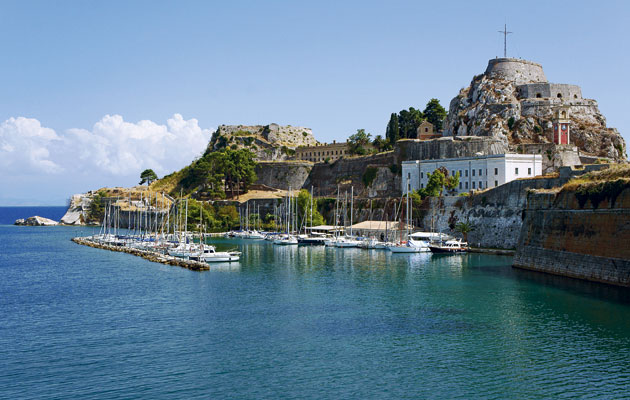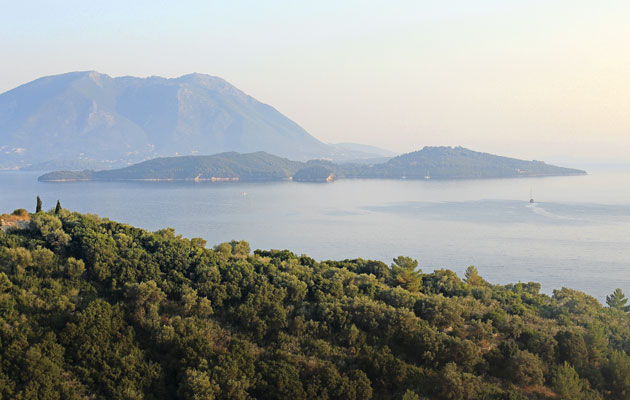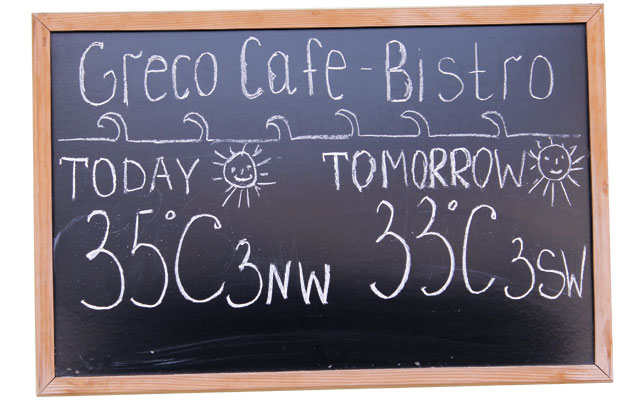The Ionian cruising ground off the Greek west coast is one of the Med's most popular destinations. Chris Beeson explains exactly why
A cruising guide to the Greek Ionian
Read about a sailing charter to the Greek Ionian
Why do hundreds of British sailors keep their boats in the Ionian Sea and thousands more head there every year to charter? Try a blend of warm, civilised winds, simple pilotage with minimal tides, good food in romantic locations and idyllic anchorages in abundant bays. If there is another area as tailor-made for easy comfortable cruising then they’re keeping it quiet. Small wonder they’ve been cruising around here for several thousand years.
Officially, the Ionian is bounded by Greece, Italy, the Adriatic and the Mediterranean, but for most sailors the name refers to the west coast of Greece, stretching from the island of Corfu in the north, south past Paxos, Levkas, Ithaca and Cephalonia to include Zakinthos in the south.
History
As you might expect, Ionian Greece is rich in history, having been ruled by the Minoans, Myceneans, Greeks, Romans, Byzantines, Normans, Venetians, Turks and, briefly, the Germans since 2000BC. However, as this area is seismically very active, there isn’t much in the way of antiquity.
The area is best known for its links with Odysseus, chronicled in Homer’s Odyssey. After the Trojan War, Odysseus headed home to resume his duties as King of Ithaca but the journey, which lasted ten years, could fairly be described as eventful, epic even. It included storm, Cyclops attacks, Aeolus’ wind bag, cannibals, Circe’s magic, Sirens, Scylla and Charybdis.
However, there is a theory, propounded by Iman Jacob Wilkens in his book Where Troy Once Stood, that Troy was in fact in the Gog Magog Downs in Cambridgeshire, and that the war was between rival Celtic clans rather than Trojans and Greeks, over Cornish tin, which was essential for the production of bronze. Odysseus’ flight was not to Ithaca but to Cadiz, which, to be fair, matches the poem’s description of Ithaca much better than the island itself, and that Odysseus’ course to Cadiz passed through the North Sea and the Channel, where Wilkens explains that Scylla and Charybdis are in fact St Michael’s Mount. Needless to say this is not a view widely held in Greece.
Recent history has been almost as turbulent due to the nation’s economic woes. Yet the Ionian islands remain stable politically. And in most respects they and the coastal mainland are better geared up than ever to meet the needs of visitors without losing their rustic charm.
So what are you likely to experience if you sail here? Let’s start with what will dictate the quality of your sailing – the wind. As a rule, this will be in the north-west. Most days start clear and calm, then a good sailing breeze, known as the maistro, of Force 3-5, builds from midday before it fades away at sunset. For novices or just for lazy days, this means perfect cruising territory.
Hello, maistro
The maistro is far gentler than the meltemi that howls down the Aegean on the east coast of Greece. Ionian gales are not unknown, but they are well forecast and do not last long. Later in the season, winds are more variable in direction.
That said, be aware that conditions can be shifty. The mountainous nature of the Ionian islands means there are plenty of localised effects as the wind converges and diverges around headlands, diverts down channels or is blocked completely, creating patches of calm and sudden gusts. Katabatic winds are also common in anchorages at the base of cliffs.
If you are chartering, flotilla or bareboat, it’s likely that either a daily weather forecast will be communicated to you or you will be briefed to call the base each morning to receive a weather update. You can also ask the port police.
Forecasts are also broadcast on VHF Ch2 and Ch85 at 0600, 1000, 1600 and 2200. You can also check Navtex Ch518. As usual, you can download GRIB files with a weather app on your smartphone where there is WiFi.
Safe in the knowledge that winds are usually benign, first-time Ionian sailors tend to ask next about the climate. Temperatures in the Ionian range from the low teens in Celsius, in January, to the mid-30s in July and August. Towards the end of the season, in September, temperatures are more comfortable at the mid-20s Celsius.
Unless you are taking your own boat across – if so bear in mind that sailing to Greece from the UK will take several months at least, much longer if you dally en route – most sailors opt to charter and arrive by plane. Budget carriers like easyJet and Ryanair fly direct to Corfu, Cephalonia and Zakinthos throughout the season. As ever, the earlier you book, the greater the bargain you can bag. Charter flights serve Levkas but tickets will be more expensive.
Another option is to make a touring holiday of the journey: drive to Italy in two or three days then catch a car ferry to Greece. These run from Venice, Ancona, Bari and Brindisi to one of Corfu, Patras, Igoumenitsa, Cephalonia and Zakinthos. The passage takes around 24 hours.
For cruisers with their own yachts there are several ports of entry. On Corfu, you can clear immigration at Corfu Port. However, because you will come a very distant second in the local pecking order to the ferries and passenger ships that stop here, a better bet is to head for Gouvia, about three miles north along the coast. Other options for clearing in include Preveza, on the mainland just north of Levkas, Argostoli on Cephalonia and Port Zante on Zakinthos.

Poiath Yacht Club is just east of the busy port of Corfu but for clearing in, you’re best bet is Gouvia
Immigration over, or your charter yacht collected, settle into the cockpit with a chart and marvel at the possibilities. Bay-hopping is a constant delight in the Ionian, with beautiful turquoise anchorages to discover, many of which are only accessible by yacht – more on this later.
For all their appeal, you will need to visit ports to refill water tanks, iceboxes and galley lockers. Even if you’re drinking bottled water, you’ll probably need to fill up water tanks every other day as after-swim and evening showers take their toll on your tanks. Even the smallest towns are likely to have a supermarket of some description to revictual and water is usually available via a hose or bowser.
Diesel can be more problematic – be prepared to grab your jerrycan and take a taxi to the nearest petrol station. Similarly, bear in mind that shorepower is not always available. Check your pilot guide (see panel right) beforehand to find out exactly what facilities are available where.
In most ports, you will be expected to moor stern-to. For first-timers this is often a source of anxiety. Certainly, it can be a little fraught if you’re not well prepared, so it pays to plan ahead. Find out how your boat behaves astern, brief the crew on what they are expected to do and when, and work out hand signals, so you don’t have to shout over the engine, windlass or fellow cruisers offering ‘advice’.
Stern-to, step by step
Before you begin to manoeuvre, prepare two stern lines, one from each quarter, and rig fenders either side to protect your topsides from other boats, including one at each quarter. Move the tender to the bow on a painter that’s long enough not to foul the anchor. Once you’ve identified your spot – be warned, it’s likely to be quite narrow – have a look at the anchor chains of neighbouring boats and try to avoid laying your chain over theirs.
If you can’t avoid it, find out what time the offended parties will leave the following morning, so you can scoot out before them. If you don’t, they could trip your anchor while recovering theirs, leaving you bouncing off the dock.
Engage astern and when you’re beginning to make way, drop your anchor three to four boat lengths from the wall and reverse straight into the gap. If possible, have a couple of crew with roving fenders on the aft sidedecks to protect against any bumps – don’t forget to tell novices never to use their hands or feet.
There is likely to be someone on the quay to take your lines, most likely a local business owner. If not, get close enough for someone to step ashore and pass the lines back aboard to secure. Once you’re happy with the setup, nip up on the windlass to keep the stern lines taut.
The most challenging situation for stern-to mooring is a stiff cross-breeze, which blows the bows off and ruins the approach. In this case, try a J-turn. Having identified where you want your anchor to drop, motor briskly astern into the wind about four boat lengths off the quay, start lowering the anchor and turn the stern towards your chosen spot. It would help to lay the right amount of chain along the sidedeck as you’re likely to be going too fast for the windlass to keep up. Your speed should prevent the bow blowing off too much. Take way off as you enter the gap, then moor as usual. Mooring stern-to in a cross-breeze is as tricky as it gets. Don’t be disheartened if the manoeuvre doesn’t work first time. Bail out, make ready and try again. If it’s just not working, anchor off or look for a berth alongside.
Money talk
Some ports charge a few euros to moor to the quay overnight. Some are quite pricey. Some don’t bother charging at all, particularly late in the season. If someone asks, show them the ship’s papers and pay what’s due. For charterers, it’s likely that your charter company has negotiated a reduced flat rate in some ports – it’s worth checking this before you book.
A possible new expense is that, as we reported last month, the Greek parliament seems set to demand that commercial or leisure yachts in Greek waters must pay a circulation tax. Charter companies will include this in their overall fee, but visiting yachts and motorboats of 7-12m will have to pay up to €400 (£335) a year. Vessels over 12m will be charged at €100 per metre every year, with concessions for permanently based yachts of either 30% or €10 per metre per month.
For all the charm of a small harbour, there’s no matching an anchorage for escapism. To make the most of the myriad options, you will need two long stern lines, 50m each at least, for lines ashore, as well as the two shorter stern lines for stern-to mooring in port. A kedge with chain and line is also useful in windier anchorages.
If you plan on exploring the shoreline or are just taking lines ashore, come equipped with some aquatic footwear. Sea urchins like the warm, shallow waters and their brittle spines can snap off then decay in your foot – a sure-fire way to spoil a holiday– and even ashore the rocks can be razor-sharp. I wear rubber-soled dive boots and a pair of sailing gloves.
Wherever you go, navigation is a doddle. One of the great joys of cruising in the Mediterranean is there is almost always somewhere gorgeous within two hours’ sailing. More often than not, pilotage is just a matter of point and go.
Even if it isn’t, the lack of tides means navigation is never especially challenging. There can be some rocks near headlands, but the seabed around most islands, particularly the more mountainous ones, shelves steeply. You can be in 800m depth within half a mile of the coast, so don’t be alarmed if your sounder gives up the ghost – beyond 100m depth, they struggle.
Indeed, the main hazard hereabouts is why you came – the sun. The heat can be oppressive in high season, especially at midday, so equip your boat with electric fans and wind scoops to ventilate cabins and make sure there’s a bimini to shade the cockpit. You might also want to consider solar panels to keep the batteries topped up. Flyscreens for hatches and the companionway are useful to keep out insects without affecting ventilation.
More annoyance than hazard, wasps appear when lunch does. Waft them away or make a simple trap with a bottle half-filled with water and honey dabbed inside the rim. Pop on the lid and give it a shake whenever an insect appears.
Pilot books and charts
The northern Ionian, including Corfu, Paxos and Levkas and the mainland coast, is covered by Imray Chart G11. Imray Chart G12 covers Levkas, Ithaca, Cephalonia, Zakinthos and the northwestern tip of the Peloponnese, and G121 covers Levkas, Ithaca, the west of Cephalonia and the mainland coast.
These charts are perfect for plotting courses and at your destination, Rod Heikell’s Ionian (7th edition, £17.95), also by Imray, takes care of the rest. There are helpful tips in Heikell’s Adlard Coles Book of Mediterranean Cruising on everything from equipping your boat for the Med and finding weather forecasts, to mooring techniques and passage planning.













